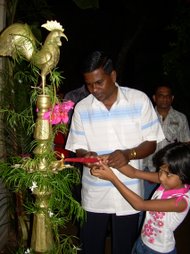Lights bright – despite dim times
The Vesak lights will glow this weekend as the country celebrates this most hallowed Buddhist festival but this year, it seems, the pandals and dansals, will be fewer as people struggle with rising costs.
Organisations responsible for setting up pandals in and around the city of Colombo said their expenses had increased significantly. K. W. Padmasiri, president of the Sri Wishakaloka pandal organisation, which puts up the pandal at Thotalanga every year, said regular donors were unable to give as generously as they had in the past. “Even the businessmen, whom we can depend on for donations, are facing financial problems themselves,” he said.
 |
Mr Padmasiri said the group put up their first Thotalanga pandal in 1955, and that this year will see their 57th production of the Vesak drama “Udaya Dhagga Jathakaya”. But costs have been almost prohibitive, he said.
“All those involved, from artists and electricians to labourers, are charging more this year,” he said. “We can’t blame them. Everything has become expensive. Last year it cost us Rs. 290,000 to put up the stage. This year it’s going to cost Rs. 360,000.”
D. M. Gunawardhena, treasurer of the Sri Wishaka Sambuddhaloka Foundation, said the biggest expense was electricity. “The bulbs, the wires, the power supply – these are the most expensive items this year, and labour costs have also gone up,” he said, adding that the organisation had so far spent close to Rs. 1,500,000 on the pandal, Rs. 300,000 more than last year.
Meanwhile, dansala organisers are cutting costs by offering ice-cream and soft drinks instead of the traditional meal of rice and curry. Nimal Priyantha of the Aruna Elle Sports Club in Thotalanga said the club had decided against putting up a dansala this year. Club members felt it would not be appropriate to go from house to house collecting donations in a time of economic hardship.
Torrington resident P. L. Dayananda said the neighbourhood’s dansala would be held over just two days, with the support of residents in the area. “Food prices have doubled this year, especially dhal and rice,” he said, adding that this year’s dansala expenses were expected to exceed one million rupees.
In busy Fort, security concerns have been uppermost on the minds of Vesak organisers, who have decided to cancel the Fort pandal and dansala this year. Premadasa Kalupahana, secretary of the Fort United Bodhiraja Society, said: “We have the money for the dansala and pandal, but we have decided instead to give it to social service organisations.”
Vesak lantern vendors too are feeling the hard times. Business has been anything but brisk for lantern vendor K. T. Somapala Perera of Kirulapone, who has another 400 lanterns left to sell off. “Lanterns are more expensive this year because the paper materials have gone up in price,” he said.
Vendor R. M. Sandamali said the average cost of a lantern was Rs. 250, and a set of six lanterns would be Rs. 1,200. The wooden structure of a lantern alone costs Rs. 40 and above,he said. In addition, the Colombo Municipal Council has raised its rentals for pavement stalls.
 Don’t Panic. It is a very simple hobby to begin. And will be a lifelong adventure as you grow your coin collection over the years. The thrill of a great find is absolutely terrific.First off; go and visit the library.
Don’t Panic. It is a very simple hobby to begin. And will be a lifelong adventure as you grow your coin collection over the years. The thrill of a great find is absolutely terrific.First off; go and visit the library.  The most recent supernova in our galaxy has been discovered by tracking the rapid expansion of its remains. This result, using NASA’s Chandra X-ray Observatory and the National Radio Astronomy Observatory’s Very Large Array, will help improve our understanding of how often supernovae explode in the Milky Way galaxy.
The most recent supernova in our galaxy has been discovered by tracking the rapid expansion of its remains. This result, using NASA’s Chandra X-ray Observatory and the National Radio Astronomy Observatory’s Very Large Array, will help improve our understanding of how often supernovae explode in the Milky Way galaxy. By Dhanesh
By Dhanesh



















































